Pruning ficus Benjamin: appointment, timing, step-by-step instructions

Ficus Benjamin is a houseplant that has no flowers. Despite this, he is very popular. The leaves provide a decorative effect. Especially beautiful varieties with spotty whitish-green leaves.
The long lifespan of the ficus plant ensures proper care. It includes not only timely watering and feeding. One of the most common and necessary procedures is related to the pruning of shoots.
What is it for?
As a result of pruning Benjamin's ficus, several problems are solved at once.
- The plant is given an unusual shape... Thanks to this, it becomes a spectacular decoration for any apartment. The process should be approached responsibly and well thought out the shape of the future bush, taking into account the growth of its branches.
- The procedure allows the plant to rejuvenate... When old branches are removed, the growth of new, young ones is stimulated.
- Ficus gets rid of sick yellowed brancheswhich make the plant unattractive.
Pruning can be done at home. It is important to follow the rules, use the appropriate equipment. After the procedure, the ficus not only becomes more beautiful, but also develops well in the future.

When to conduct?
The trimming time depends on its type. Sanitation is a necessary measure, so there are no time requirements for it.
If you decide to rejuvenate the plant or give its crown a certain shape, then you need to trim the ficus when it is at rest... Otherwise, the tree will weaken, it will hurt and recover for a very long time.
The ideal time for the procedure is spring (from March to April), when the buds swell and the foliage renews. By the time active growth begins, the wounds and cuts will already be overgrown.
In autumn and winter, the ficus does not need to be touched. The plant will be deprived of the entire supply of nutrients that it has accumulated over the year.
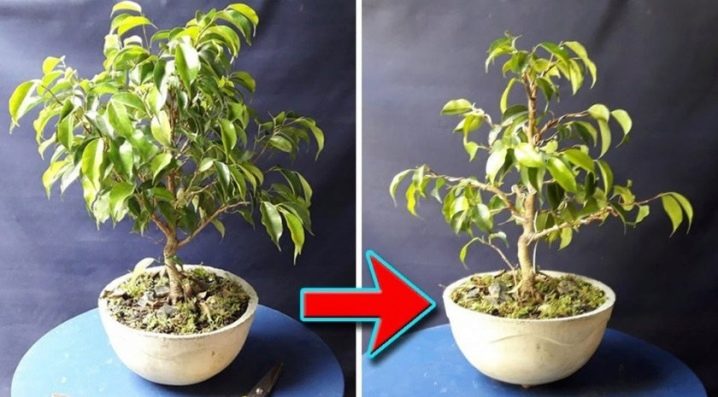
Necessary tools
You will need a sharp pruner or knife. The branches at the base can be carefully trimmed with small nail scissors, since the pruner is very bulky - it will be inconvenient for them to operate. An alternative to scissors is a clerical knife. Its blade is very sharp. Regular scissors can handle thin branches.
Before starting the procedure, all inventory must be thoroughly disinfectedso as not to introduce pathogenic bacteria into the wounds of the tree. For processing the blades of knives, pruners, scissors, any alcohol solution or potassium permanganate diluted in water is suitable. You can also ignite tools over a fire.
You will also need a sterile wipe to blot the cut plant sap, activated charcoal, and gloves.
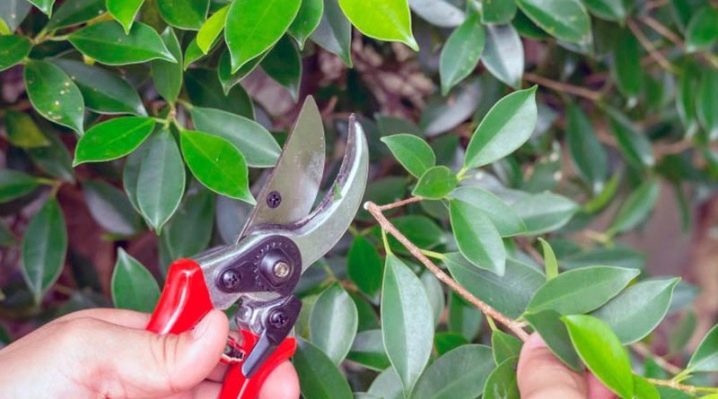
Types and rules of pruning
Pruning is needed for the ficus to grow and develop well. It is important to take into account that it is necessary to cut off not only the branches, but also the roots.... If the root system is noticeable or even has left the pots, this excess needs to be trimmed. Pruning will not do any harm. Moreover, the tree will begin to eat better and will actively begin to build up shoots and foliage.
Dried shoots are removed almost completely to the ground. The minimum number of buds that must remain on the branches is two.... By analogy with percentage, about 90% of the branch length is removed.This should not confuse or scare you - after pruning, the tree will begin to grow even better.
You can trim the ficus gradually: first, remove one half of the branches, and after a while, when the ficus is restored, the other.
The process should be carried out according to step-by-step instructions.
- Examine the plant carefully. Identify dry twigs. Cut them with pruning shears to the base, that is, to the place where live shoots are present.
- Cut the tips of healthy branches straight, so that the ficus grows and becomes more fluffy. The more "tails" are cut off, the more new branches will appear in an adult plant. Thick branches are cut at an angle.
- If the tree is quite old and dry branches with a diameter of about 1.5-2 cm were found on it, after pruning, this area should be well cleaned and greased with garden varnish.
- If you identify signs of damage to the plant by parasites (for example, a scabbard), first carry out pruning, and then measures to exterminate insects. This sequence of actions is most effective:
- less drug is consumed;
- due to the thinned crown, the product will easily penetrate to all leaves and branches.
- White milky juice appears in the cut areas - blot it with a napkin. Places where the cut has a diameter of more than 2 mm, sprinkle with crushed activated carbon, grease with garden balsam. On thin branches, just remove the juice with a napkin, the rest of the tree will do everything by itself.
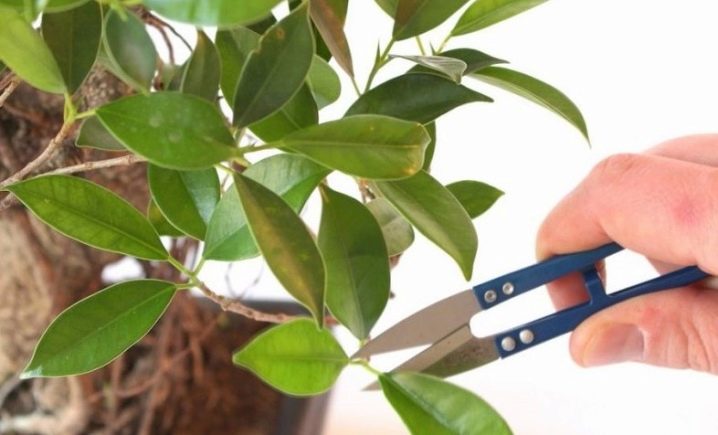
Sanitary
This type of processing is carried out when the need arises. It is designed to rid the tree of dried, old and diseased shoots, those that do not develop well. It is possible that the reason for their unattractiveness lies in the disease. In this case, the removal of such branches is simply necessary, because they can become a source of infection for the entire plant.
Keep an eye on your pet, and as soon as you notice such alarming signals, do not delay and start pruning. Remove diseased branches to where healthy shoots grow... Prune under the ground at the base of the plant.
Sanitization makes the crown less frequent and thus facilitates better light penetration to the inner branches. There are no special time requirements.
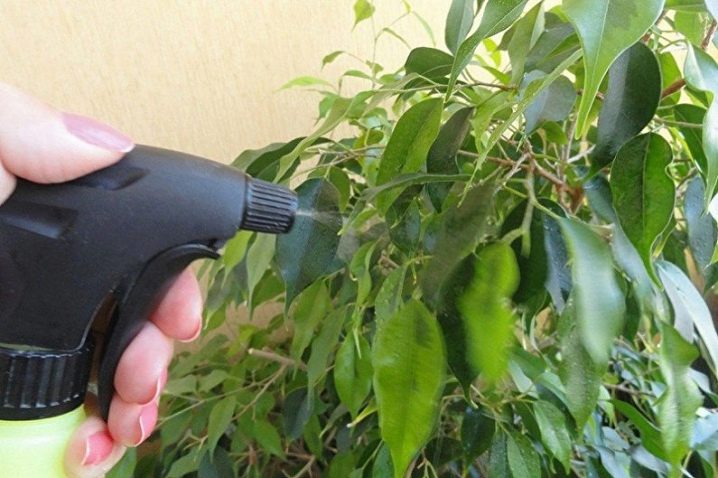
Rejuvenating
Such pruning is necessary for old trees or those whose top has lost its decorative appearance. This may be due to drying out or frostbite, when you inadvertently chilled the ficus during the winter airing of the room. The process will allow the tree to grow quickly.
This type of procedure is especially recommended for ficuses with very long shoots. Over time, they lose their foliage due to lack of light and moisture.
Crown and trunk shapes
Crown formation is a mandatory process. A properly carried out haircut will turn the plant into a real interior decoration. Ficus, in order to be fluffy, needs to pinch the central shoot. Then he ceases to stretch upward, his lateral branches will actively begin to develop. A year later, a lush bush is obtained, which can be further given a different shape, for example, made into a ball.
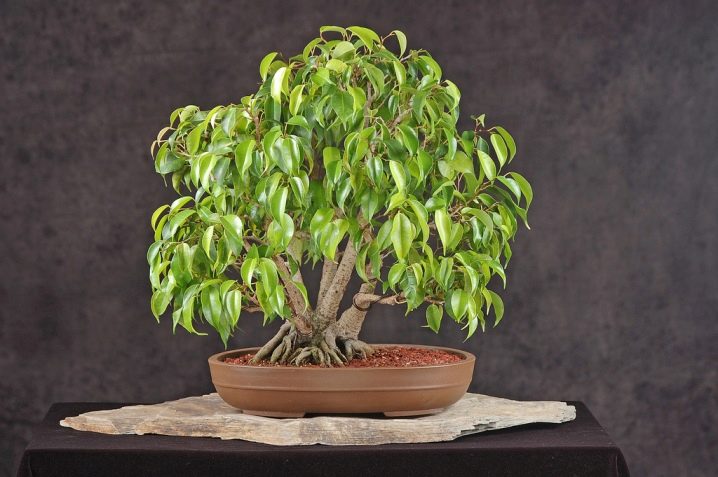
Stam
The ficus of the standard form has a powerful trunk, the crown is trimmed with a ball, an oval. This plant looks very beautiful. To grow it, you need a single cutting. Root it in a planter and prune side branches as it grows. Leave only the top 3-4 pieces.
Pay attention to the proportions: when the tree grows half a meter (the standard length of the desktop version), the trunk, devoid of branches, should be about 20 cm long.
If you want to grow a floor version of ficus, then when it reaches a height of 90–100 cm, cut the upper shoot by 5–10 cm. After the procedure, the plant will actively release side branches. Leave them only in the place where the crown is formed, and cut off those that appear on the trunk.
The tiered bole looks especially impressive... There can be several tiers. They are all separated from each other by a bare trunk.Tier build-up is a gradual process.
It can be done in two ways.
- First, a standard stem is modeled (as described above). Next, leave the central (one) shoot, which is directed upward. It will be a kind of connecting link between the tiers. On it, a few cm from the first crown, the second is formed.
- You can plant two cuttings by connecting them tightly with wire. As they grow, the stems will join at the base and form one common trunk. After the formation of the first crown, divide it, trim one to stop its growth. The second plant will grow further and form the second tier.
This method allows you to experiment with ficuses with different leaf colors. Take one cut from a plant with solid foliage and the other with yellow blotches.

Arc
To grow such a ficus, you will have to wrap the stem of the plant with wire and give it the shape of an arc. The same principle is used to grow and bonsai from ficus. Viandi is the ideal variety for this.... Its trunk is naturally curved, and such a ficus grows more slowly than its other counterparts. If you do not have this variety, use the available Benjamin ficus.
First, pick up a low, wide bowl with a drainage hole. Fill it with soil and plant the stalk. After it takes root, you can start forming a tree.
Ficus branches are plastic, bend in different directions. In order to give them the correct bend, use a wire, twisting each in a spiral. It is better to take with an insulating cover so as not to injure the bark of the tree.
Not only branches are pruned from such a ficus, but also the roots. The procedure is carried out 2-3 times a year... In this way, a real bonsai can be grown at home in about five years.

Bush
You will need a few cuttings. They are rooted in pots close to each other. The procedure can be carried out with any varieties of Benjamin ficus: low or high. When the plants are 15 cm long, pinch the top. There must be at least 5 leaves on the shoot... As a result, each cutting will give more shoots from the side - 4–5 pieces. After they reach 15 cm, do the same with them, cutting off the top. Pay attention to the upper kidneys: they should be directed outward. Wipe the cut areas with a napkin, sprinkle with charcoal.
If you get a very dense bush, thin it: remove several large branches from the middle. In order for the growth of branches to occur evenly, provide the ficus with good lighting and be sure to turn it at different angles to the light source.

Pyramid
It is important to stick to the shape when trimming. The base of such a tree should be wide, tapering towards the top. Adjustments are made as the branches grow.
Features of care after the procedure
After pruning, the ficus needs proper care. Since you reduced the number of branches, the tree will now need much less moisture, so reduce watering.
To make the growth of the shoots more intense, you can use growth stimulants and periodically spray the plant with them.
A fragile plant does not need bright sunlight: it can cause burns. Shade the ficus.

Specialist recommendations
Ficus Benjamin can be called the ideal plant for beginners. It quickly becomes overgrown with foliage, so you can practice your skills well on it.
Experts do not recommend starting experiments to give an unusual shape to the crown on a ficus that is less than three years old.... It is not worth delaying either: an adult plant will hardly tolerate pruning and will take a long time to recover.
Water the ficus thoroughly before starting the procedure.
Take your time, predict the result before cutting each branch.
In the next video, you will find some tips for pruning ficus.































The comment was sent successfully.